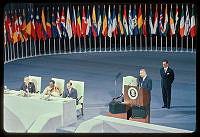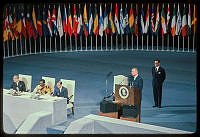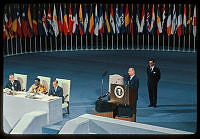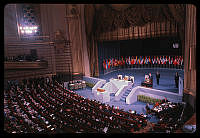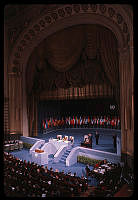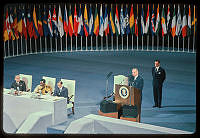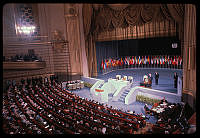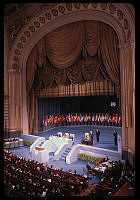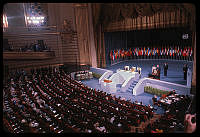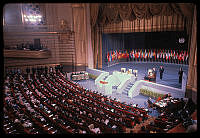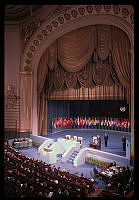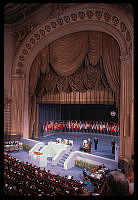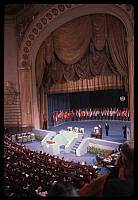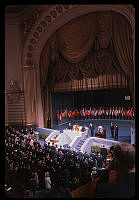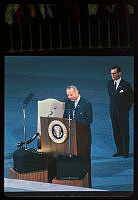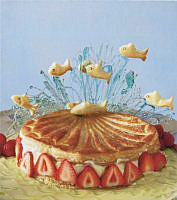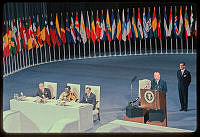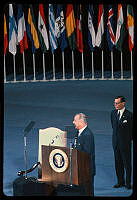Fashion and Frugality
First Lady Sarah Polk
Copyright © Fall 2012 White House Historical Association. All rights reserved under international copyright conventions. No part of this article may be reproduced or utilized in any form or by any means, electronic or mechanical, including photocopying, recording, or by any information storage and retrieval system, without permission in writing from the publisher. Requests for reprint permissions should be addressed to books@whha.org

Detail of floral ribbons and lace trimming a pink satin brocade ball gown that belonged to Sarah Childress Polk. The gown fits the description of a “robe satin rose” made for Mrs. Polk by Madame Oudot Manoury in Paris in 1847. The gown cost 500 francs (about $100). Unless otherwise noted, the costumes of Mrs. Polk shown here are in the collection of the Polk Home, Columbia, Tennessee.
Polk Home CollectionSarah Childress Polk (1803–1891) was first lady from 1845 to 1849, during the administration of her husband, James Knox Polk. A fashion trendsetter, she used her keen intelligence, abiding religious faith, pleasant manner, and superb organizational skills to artfully regulate the White House, serve as her husband’s main political partner, and orchestrate an exhausting social schedule of receptions and dinners that helped Polk achieve his entire political agenda in a single term. The Polk years witnessed war with Mexico, expansion of American territory from coast to coast, and establishment of a permanent treasury.
An early commentator on Washington society wrote that Sarah Polk was “fitted by nature, education andxtensive intercourse with the best society” to execute her role as first lady.1 The daughter of a prosperous tobacco and cotton planter, Sarah Childress grew up wearing fashionable silks and satins. She received an excellent education for women of her day at academies in Nashville and in Salem, North Carolina. The famous Moravian school near the present city of Winston-Salem continues as Salem College today. At an early age, Sarah Polk began to freely engage in political discussions at the family plantation near Murfreesboro, onetime capital of Tennessee.2
James K. Polk served in Congress for fourteen years and from 1835 to 1838 was Speaker of the House. He then served one term as Tennessee governor. Sarah Polk had ample time to master the social as well as the business side of national politics. The two seem to have interested her equally. She moved to the White House with a sense of style as solid as her sense of self. “At her grand levees, in full dress” wrote another commentator “she is a most imposing, magnificent looking woman.”3
Some grumbled about Mrs. Polk’s prohibition against dancing, cards, and hard liquor in the White House, but they respected her refined deportment, her genuine faith, and her profound respect for the office of the presidency. Detractors complained about her frankness and overt involvement in politics, but she was good at what she did; and the future chief executive Franklin Pierce observed that he would rather talk politics with Sarah Polk than with her husband.4 She and the president shared an office in the family quarters, the upstairs Oval Room, where she read and marked items of interest for his perusal. Kind but firm, she informed the ladies of the city that she would not return their calls, recruiting the nieces instead to perform the arduous chore. Thus she cut from her life one of the most cherished and burdensome duties of the president’s wife.

Sarah Polk posed in the White House for this portrait by George Peter Alexander Healy in 1846. The artist captured her tastes. She favored silks, satins, and velvet, like the claret-colored velvet example she wears here. Designs for her dresses were those current in the Paris of Louis-Philippe.
James K. Polk Ancestral Home CollectionThe Polk White House was dignified and elegant. Dressing well was an established way for the president and first lady to convey the importance of the office, and Polk’s expansionist agenda encouraged the first couple to surround themselves with some trappings of empire befitting the leading exponent of Manifest Destiny. Mrs. Polk knew her place and never went too far. American citizens wanted a first lady who looked like a queen but did not act like one. In this respect she was carrying on the tradition of Dolley Madison, who passed her final years in Washington as the grand dame of society. Elizabeth Monroe and Louisa Adams had been exemplars of high fashion, but they were never as successful as the gregarious Dolley Madison in reaching across the political aisle and making everyone feel at ease.
Mrs. Polk and Mrs. Madison became close friends. At the Polks’ first public reception on January 21, 1846, the president took Mrs. Madison’s arm for the promenade in the East Room, where “the dresses of the ladies form[ed] a subject of abstruse study.”5 Sarah Polk also had a discreet and experienced confidant in the venerable Dolley Madison, who maneuvered successfully among fractious congressmen during “Mr. Madison’s War” more than three decades before the conflict with Mexico.
The Polks continued the Jacksonian practice of opening the White House to visitors of nearly every ilk. There were twice weekly evening receptions and frequent formal dinners, morning hours for callers, and the traditional grand receptions held on New Year’s Day and the Fourth of July, at which “the world and his wife” were in attendance.6 During the war with Mexico, they stepped up their entertainment schedule, no doubt to shore up support from Congress.
Mrs. Polk welcomed everyone equally, but set a dignified tone. The first lady dressed àla mode without being overly flashy. “She has excellent taste in dress,” wrote the Englishwoman Sarah Mytton Maury, “and ... preserves the subdued though elegant costume which characterizes the lady.”

Sarah Polk continued a fashion for wearing turbans made famous in the White House thirty years earlier by Dolley Madison. This example in Tunisian blue plaid silk with a tassel may be the one purchased in Paris in 1847 from the celebrated milliner Alexandre & Beaudrant.
James K. Polk Ancestral Home CollectionFashionable women of the era paid close attention to accessories. “Mrs. Polk is very handsome in the evening,” wrote e lizabeth Dixon, the wife of Connecticut Senator J. e . Dixon, after a White House dinner in December 1845. The first lady wore “a scarlet cashmere turban embroidered in gold and trimmed with gold fringe on her ‘back hair.’” Positioning headdresses in this manner allowed ladies to fully show off the stylish trend for sausage ringlets framing their faces. The gown of dark blue velvet was trimmed with Brussels lace; a Brussels lace scarf was draped around her neck, extending nearly to the floor.8 On New Year’s Day, Mrs. Dixon found the first lady dressed in “claret coloured” velvet with a plume in her dark hair.9 Mrs. Polk may have worn the same gown, ornamented with a velvet headdress and gold tassel, when she sat for a portrait by George Peter Alexander Healy in 1846.
Sarah Polk adhered to styles of the mid-1840s, wearing tight corsets beneath dresses and gowns with closely fitted sleeves and bodices above full, bell-shaped skirts puffed up with crinolines. Shoes worn inside were often flat, in kid or satin. She covered her head with bonnets and hats for outside excursions. For indoor appearances, she preferred fancy lace caps, or handsomely decorated headdresses and turbans of silk, satin, or velvet. Like other good republicans, she eschewed precious gems for jewelry, preferring coral, cameo, and paste. One visitor to the White House sniffed that the Polk women were outfitted with “giant stone breastpins.”10
After their marriage in 1824 James and Sarah Polk practiced thrift, a habit that they carried into the White House, despite the high costs of frequent entertaining and maintaining proper appearances. The first lady developed dress patterns that she liked and then hired seamstresses to make them using elegant and expensive materials—velvet, satin, and silk—decorated with imported fringe, ribbons, and lace. She avoided frills and preferred solid colors that flattered her exotic dark hair and olive complexion.

Fashionable women of Sarah Polk’s era often wore their hair parted in the middle with large, sausage sized ringlets framing their faces. Headdresses, like this purple velvet “wreath” worn by the first lady, were placed on the “back hair.”
James K. Polk Ancestral Home Collection
The collection at the Polk Home contains a variety of headdresses decorated with ribbons, tassels, glass beads, gold and silver thread, and artificial flowers.
James K. Polk Ancestral Home CollectionInvoices in the James K. Polk Papers at the Library of Congress show that dress fabrics, hats, bonnets, headdresses, parasols, gloves, net and lace mitts, shoes, hose, lace and crepe shawls, capes, scarves, parasols, and even one $50 merino wool cloak were purchased with regularity from Washington shops.11 Alexander Stewart Company in New York also supplied some dresses and shawls for the White House in 1845 and during the summer of 1847.12
Sarah Polk used her own dressmaker, a free black woman documented only by her name, Teresa, and turned to other Washington seamstresses to create clothing for herself and her nieces.13 Solid, striped, plain, and “changeable china” silks were staples. More formal wear called for satin and velvet materials in various colors, including pink, red, blue, green, and black.
Paris dominated nineteenth-century fashion designs. Conscientious American women read newspapers and a growing number of ladies magazines to follow the latest trends. During her own eight years as first lady in the Federal City, Dolley Madison wore elegant gowns and headdresses imported from France, a practice continued by several of the presidential wives who followed her. Sarah Polk kept the tradition alive. French accessories, available as imports from the local merchants, were a part of her wardrobe.

The collection at the Polk Home contains a variety of headdresses decorated with ribbons, tassels, glass beads, gold and silver thread, and artificial flowers.
James K. Polk Ancestral Home Collection
The collection at the Polk Home contains a variety of headdresses decorated with ribbons, tassels, glass beads, gold and silver thread, and artificial flowers.
James K. Polk Ancestral Home CollectionDuring the summer of 1847, the first lady placed an order for clothing from Paris. The gowns and accessories cost nearly $450 and arrived in November of that year.14 The order was executed under the guidance of J.L. Martín in Paris. The purchases included a pink satin ball gown and an evening dinner gown in the style named for Madame de Pompadour (1721–1764), the chief mistress of Louis XV who had popularized gowns with open skirts edged with elaborate flowers, bows, and ribbons framing an exposed ruffled petticoat. The nineteenth-century adaptations of the style often featured closed skirts decorated with flowers, bows, and ruffles to resemble the earlier fashion.
The two gowns were made to order by one of the best known couturières of the era, Madame Oudot Manoury.15 One British magazine in 1835 applauded Manoury’s “taste of a ... chaste and elegant style,”16 an approach entirely suitable to the first lady’s established look. Manoury is credited with reviving the use of narrow fitted sleeves, which replaced the puffed leg-o’-mutton style of the 1830s. A Philadelphia publication in 1838 cited this innovation and included her name among the finest Parisian designers of the era, noting pointedly that the French designers were the only artist class in that nation to excel, “except the cooks.”17

This dark green velvet dinner gown is among the gowns made for the first lady by seamstresses working in the Federal City. It followed the basic form Mrs. Polk preferred, and it could be elaborated with lace, artificial or real flowers, jewelry, and even feathers to make it different for different occasions.
James K. Polk Ancestral Home Collection
This dark green velvet dinner gown is among the gowns made for the first lady by seamstresses working in the Federal City. It followed the basic form Mrs. Polk preferred, and it could be elaborated with lace, artificial or real flowers, jewelry, and even feathers to make it different for different occasions.
James K. Polk Ancestral Home CollectionA Madame Moulton, whom Martin described as “a fair friend,” supervised the commission. Martin assured Mrs. Polk that she was not only “adept, but an example of good taste and elegance.” Martin described the pink satin ball gown adorned with and lace and ribbons as the most elegant of the dresses—it cost nearly $100—“the greatest part of which is for the lace upon it, ... 7 or 9 yards of the finest Pointe d’Angleterre application, without being cut, which will keep & answer afterward for other purposes.” Warming to his role as fashion critic, he continued, “There is nothing the fair Parisians admire as much as a fine lace & a ball dress is considered distinguished in proportion to the quantity and quality which it contains.”18
An impressive assortment of dresses and accessories survive at the James K. Polk Ancestral Home. During the 1840s ladies wore small evening headdresses decorated with tassels, ribbons, glass beads, gold and silver thread, artificial flowers, and ostrich or ibis plumes. Madame Moulton visited the famous Paris milliner Alexandre & Beaudrant for five headdresses, all “very beautiful & of the latest style.”23 The most elaborate headdress was made of silver and blond lace tulle embellished with white plumes. Two “remarkable” hats—one white and the other pink—came from the shop of M. Drouart, purveyor to the queen of France.24

Sarah Polk’s grand pink satin brocade ball gown fits the description of an elaborate gown made for her by the Paris couturière Madame Manoury. This off-the-shoulder neckline is styled with pleats and adorned with floral ribbons at the shoulders and on the front of the skirt. For occasions requiring more modesty the designer included a chemisette to cover the first lady’s bare neck and shoulders. The deep V bottom of the bodice and short sleeves follow Sarah Polk’s preferred pattern, but the construction and other sophisticated details are French in style, rendered in perfection.
James K. Polk Ancestral Home Collection
Sarah Polk’s grand pink satin brocade ball gown fits the description of an elaborate gown made for her by the Paris couturière Madame Manoury. This off-the-shoulder neckline is styled with pleats and adorned with floral ribbons at the shoulders and on the front of the skirt. For occasions requiring more modesty the designer included a chemisette to cover the first lady’s bare neck and shoulders. The deep V bottom of the bodice and short sleeves follow Sarah Polk’s preferred pattern, but the construction and other sophisticated details are French in style, rendered in perfection.
James K. Polk Ancestral Home CollectionThe Polk Home owns silk, velvet, and satin headdresses, some still ornamented with glass beads, artificial flowers, and gold or silver thread. One wreath shaped headpiece is made of hat wire and raffia wrapped in purple velvet, the circlet sporting a purple satin ribbon flower. The Polk White House acquired a set of dining room chairs covered in purple velvet in 1845. Sarah Polk purchased “1 yd. purple velvet” in Washington the next year, perhaps in an effort to emphasize the fashionable setting for frequent presidential dinners by wearing a matching headdress in her hair.25 Simple construction points to American manufacture.
Sarah Polk wore turbans—still in style in Paris—but she wore them on the back of her hair, instead of at the forehead, as was the fashion in Dolley Madison’s day. The order from France included one example made of Tunisian blue silk with fringe. One plaid silk Tunisian blue fringed turban survives in the Polk Home.26

Deep blue silk and satin striped long-sleeved day dress with quilted silk lining, attributed to the shop of Paris couturière Oudot Manoury. In her 1847 invoice, Mme Manoury described the gown as a “robe de chambre à la Pompadour,” the French term for a dressy house coat or dressing gown. The traditional Pompadour form is defined by the open skirt edged with ribbon and the bows on the sleeves and skirt. Unlike the French upper class, American women did not ceremoniously receive guests in their bedrooms. Sarah Polk might have worn the gown as a day dress to receive morning callers in the oval room upstairs at the White House, but the near perfect condition of the garment suggests it was rarely worn at all.
James K. Polk Ancestral Home Collection
Deep blue silk and satin striped long-sleeved day dress with quilted silk lining, attributed to the shop of Paris couturière Oudot Manoury. In her 1847 invoice, Mme Manoury described the gown as a “robe de chambre à la Pompadour,” the French term for a dressy house coat or dressing gown. The traditional Pompadour form is defined by the open skirt edged with ribbon and the bows on the sleeves and skirt. Unlike the French upper class, American women did not ceremoniously receive guests in their bedrooms. Sarah Polk might have worn the gown as a day dress to receive morning callers in the oval room upstairs at the White House, but the near perfect condition of the garment suggests it was rarely worn at all.
James K. Polk Ancestral Home CollectionA daguerreotype of the presidential couple, taken at the White House, shows Sarah Polk wearing what may be a tassled headdress. She wears a dress covered by a cape or coat, further covered by a lace shawl. Real or artificial sleeves cover her arms to the wrist. The cloak may be the “black watered silk” coat that the first lady wore to attend the Presbyterian Church in December 1845 in the Federal City. She arrived fashionably late sporting a black hat with a large white plume.27

The daguerreotype of President and Mrs. Polk was made by John Plumbe’s studio in Washington, D.C., 1848–49. The first lady is wearing a watered silk cloak, covered by a lace shawl. Her headdress sports a tassel framing the left side of her face.
James K. Polk Ancestral Home CollectionThe photograph shows a cameo pin at the first lady’s neck. Sarah Polk had several cameos, a jewelry stone made fashionable by Napoleon and later by Queen Victoria. In March 1847, James K. Polk paid a $12.00 invoice from the New York Firm of Arrowsmith, Guest & Bernard for an engraved gold mounting for a “cameo likeness.” The order was placed by “Mr. S. Ellis.” Salathiel Ellis (1803–1879), a native of Vermont, advertised as a “cameo cutter, and maker of “cameo portraits” in New York City, 1842–48.28 He is also known for the silver Indian Peace Metals crafted for later presidential administrations. Sarah Polk was fond of the portrait brooch of her husband and wore it often until her death.
The Polk Home collection in Tennessee includes examples of lace shawls and embroidered scarves, mitts and artificial sleeves, coral, paste and jet jewelry, and tortoiseshell combs, which, when worn with one of her mantillas, led some to call Sarah Polk “The Spanish Donna.” A sampling of reticules and purses complete the holdings. One pair of white flat slippers attests to the first lady’s size. Some described her as tall, but the document clothing suggests a woman of no more than 5 feet 3 inches. No doubt her erect carriage lent stature.

Cameos were a favorite form of jewelry. This example features a cameo portrait of President Polk made by Salathiel Ellis in 1847. The gold chased mounting is by Alexander & Counts.
James K. Polk Ancestral Home CollectionUnfortunately, the first American-made bonnet containing more than 140,000 yards of woven glass threads, presented to the first lady in May 1846 at the National Fair, has not been located, but the Polk Home collection includes many fans, including the paper and ivory example bearing the portraits of the first eleven presidents, presented by Polk to his wife for her to carry during his inauguration.29 The reverse side shows the signing of the Declaration of Independence.

This painted paper and ivory fan bearing the portraits of the first eleven presidents was given to Mrs. Polk by her husband to carry during his presidential inauguration festivities. The reverse side shows the signing of the Declaration of Independence.
James K. Polk Ancestral Home CollectionThe role of first lady is not defined in the Constitution, leaving each mistress of the White House to fend for herself in securing the approbation of a vocal and partisan public. Fully aware that she was performing without a net, Sarah Polk nimbly traveled the tightrope of public opinion without a major stumble. Given her frankness, her strong moralistic views, and her active political involvement, it was a remarkable achievement.
Nearly a decade after Sarah Polk left the White House, one observer described her as “the lady who has presided at the executive mansion with a wider popularity than has since been obtained by any one of her successors.”30 Fashion sense was an asset, but only one of the many reasons for her extraordinary success.

A blue satin brocade gown in the First Ladies Hall at the Smithsonian Institution, features flounces in the center of the skirt, the edges trimmed with floral ribbons characteristic of the Pompadour style.
Division of Political History, National Museum of American History, Smithsonian Institute
This silk bodice, laced at the back, tightly fitted over a corset, would have been accompanied by a long-sleeved blouse, probably a lace “bertha” or draped collar, and a large bell-shaped skirt.
James K. Polk Ancestral Home Collection













